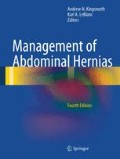Abstract
The lumbar area is bounded above by the 12th rib, below by the iliac crest, behind by the erector spinae (sacrospinalis) and in front by the posterior border of the external oblique (a line passing from the tip of the 12th rib to the iliac crest). Within this area two triangles are described: the superior lumbar triangle (of Grynfelt) and the inferior lumbar triangle (of Petit). The superior lumbar triangle is an inverted triangle, its base is the 12th rib, its posterior border is the erector spinae and its anterior border the posterior margin of the external oblique, its apex is at the iliac crest inferiorly. The base of the inferior lumbar triangle is the iliac crest, its anterior border is the posterior margin of the external oblique muscle, its posterior border is the anterior edge of the latissimusdorsi muscle and its apex is superior. Both the superior and the inferior lumbar triangles vary in size depending on the attachments of muscles to the iliac crest (Fig. 19.1). The floor of both triangles is the thoracolumbar fascia incorporating the internal oblique and the transverses abdominis to a variable degree.
Access this chapter
Tax calculation will be finalised at checkout
Purchases are for personal use only
References
Gardner GP, Josephs LG, Rosca M, et al. The retroperitoneal incision. An evaluation of postoperative flank bulge. Arch Surg. 1994;129:753–6.
Hoffman RS, Smink DS, Noone R, et al. Surgical repair of the abdominal bulge: correction of a complication of the flank incision for retroperitoneal surgery. J Am CollSurg. 2004;199:5.
Adamson RJW. A case of bilateral hernia through Petit’s triangle with two associated abnormalities. Br J Surg. 1958;46:88–9.
Myers RN, Shearburn EW. The problem of recurrent inguinal hernia. Surg Clin North Am. 1973;53:555–8.
Watson LF. Hernia: anatomy, etiology, symptoms, diagnosis, differential diagnosis, prognosis, and the operative and injection treatment. 2nd ed. London: Harry Kimpton; 1938.
Geis WP, Saletta JD. Lumbar hernia. In: Nyhus LM, Condon RE, editors. Hernia. 3rd ed. Philadelphia: Lippincott; 1989.
Stumpf M, Conze J, Prescher A, et al. The lateral incisonal hernia: anatomical considerations for a standardized retromuscularsublay repair. Hernia. 2009;13:293–7.
Yavuz N, Ersoy YE, Demirkesen O, et al. Laparoscopic incisional lumbar hernia repair. Hernia. 2009;13:281–6.
Kretschmer HL. Lumbar hernia of the kidney. J Urol. 1851; 65:944–8.
Esposito TJ, Fedorak I. Traumatic lumbar hernia. Case report and review of the literature. J Trauma. 1994;37:123–6.
McCarthy MC, Lemmon GW. Traumatic lumbar hernia: a seat belt injury. J Trauma Injury Infect Crit Care. 1996;40:121–2.
Burt BM, Afifi HY, Wanz GE, et al. Traumatic lumbar hernia: reports of cases and comprehensive review of the literature. J Trauma. 2004;57:1361–70.
Bathla L, Davies E, Fitzgibbons RJ, et al. Timing of traumatic lumbar hernia repair: is delayed repair safe? Report of two cases review of the literature. Hernia. 2011;15:205–9.
Chatterjee S, Nam R, Fleshner N, et al. Permanent flank bulge is a consequence of flank incision for radical nephrectomy in one half of patients. Urol Oncol Seminars Orig Invest. 2004;22:36–9.
Copeman WSC, Ackerman WL. Fibrositis of the back. Q J Med. 1944;13:37–40.
Faille RJ. Low back pain and lumbar fat herniation. Am Surg. 1978;44:359–61.
McCarthy MP. Obturator hernia of the urinary bladder. Urology. 1976;7:312–4.
Zhou X, Nve JO, Chen G. Lumbar hernia: Clinical analysis of 11 cases. Hernia. 2004;8:260–3.
Solaini L, di Francesco F, Gourgiotis S, et al. A very simple technique to repair Grynfeltt-Lesshaft hernia. Hernia. 2010;14:439–41.
Carbonell AM, Kercher KW, Sigmon L, et al. A novel technique of lumbar hernia repair using bone anchor fixation. Hernia. 2005;9:22–6.
Aird I. Companion in surgical studies. 2nd ed. Edinburgh: Churchill Livingstone; 1957.
Akita K, Niga S, Yamato Y, Munata T, Sato T. Anatomic basis of chronic groin pain with special reference to sports hernia. Surg Radiol Anat. 1999;21:1–5.
Iannitti DA, Biffl WL. Laparoscopic repair of traumatic lumbar hernia. Hernia. 2007;11:537–40.
Palanivelu C, Rangarajan M, John SJ, et al. Laparoscopic transperitoneal repair of lumbar incisional hernias: a combined suture ‘double-mesh’ technique. Hernia. 2008;12:27–31.
Habib E. Retroperitoneoscopic tension-free repair of lumbar hernia. Hernia. 2003;7:150–2.
Salameh JR, Salloum EJ. Lumbar incisional hernias: diagnostic and management dilemma. JSLS. 2004;8:391–4.
Zieren J, Menenakos C, Taymoorian K, et al. Flank hernia and bulging after open nephrectomy: mesh repair by flank or median approach? Report of a novel technique. Int Urol Nephrol. 2007;39:989–93.
Author information
Authors and Affiliations
Corresponding author
Editor information
Editors and Affiliations
Rights and permissions
Copyright information
© 2013 Springer Science+Business Media London
About this chapter
Cite this chapter
Śmietański, M. (2013). Lumbar Hernia. In: Kingsnorth, A., LeBlanc, K. (eds) Management of Abdominal Hernias. Springer, London. https://doi.org/10.1007/978-1-84882-877-3_19
Download citation
DOI: https://doi.org/10.1007/978-1-84882-877-3_19
Published:
Publisher Name: Springer, London
Print ISBN: 978-1-84882-876-6
Online ISBN: 978-1-84882-877-3
eBook Packages: MedicineMedicine (R0)

